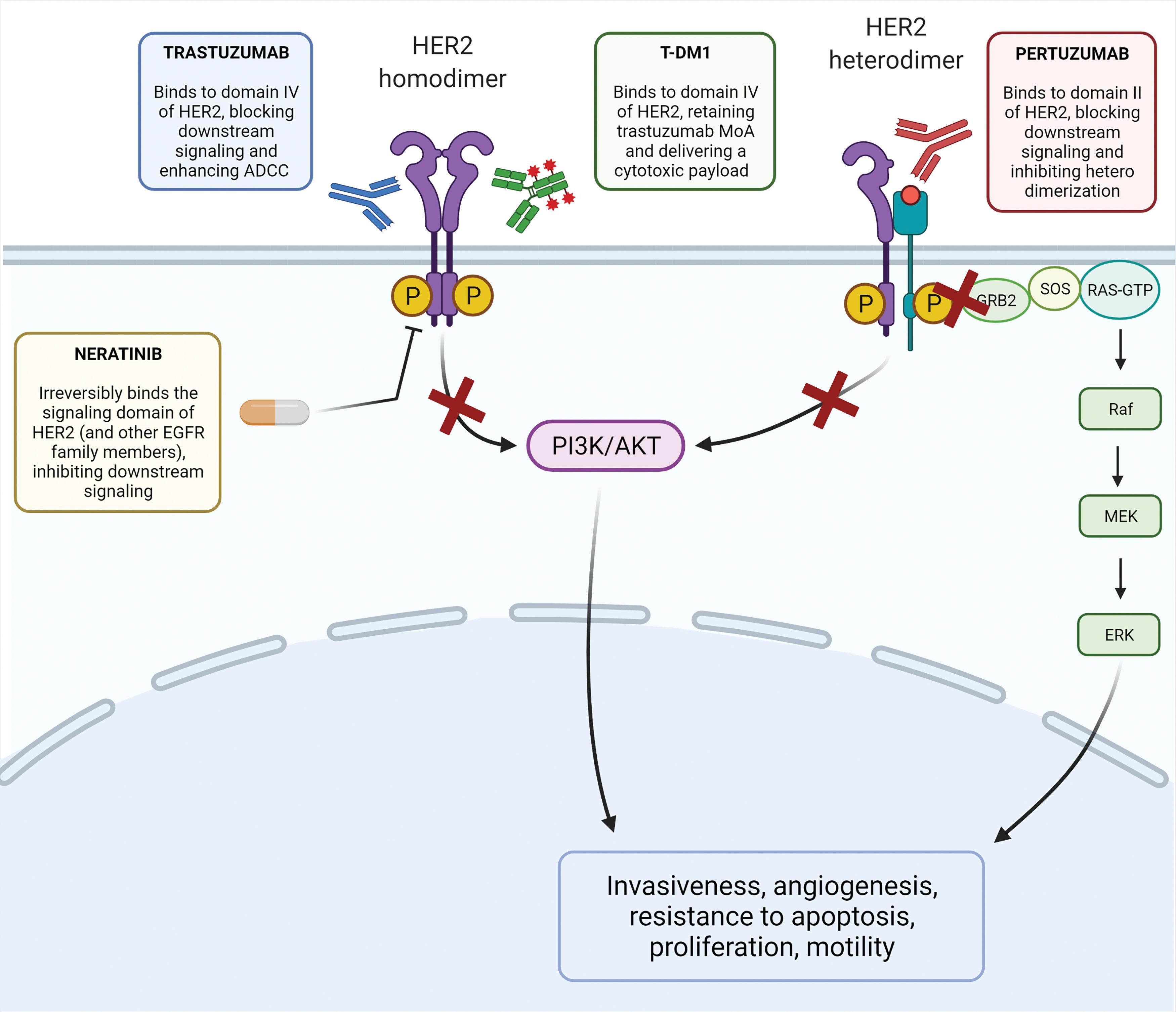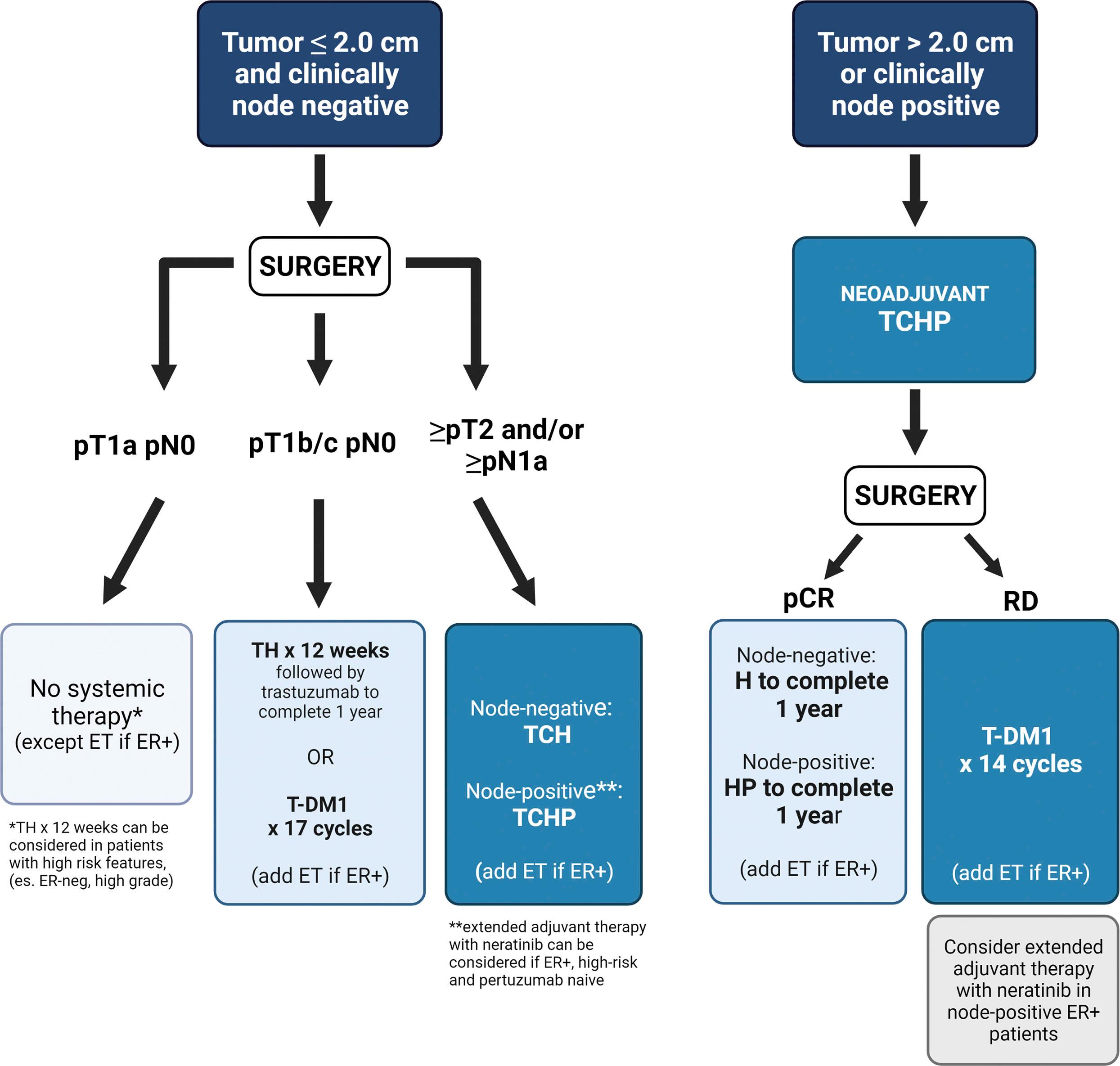Physical Address
304 North Cardinal St.
Dorchester Center, MA 02124
HER2 (also known as ERBB2) represents a potent oncogenic driver in 15% to 20% of breast carcinomas and is associated with an aggressive phenotype and poor patient outcome if not treated. The addition of trastuzumab, the first monoclonal antibody targeting HER2, to chemotherapy for early-stage, HER2-positive breast cancer has significantly reduced recurrence of and mortality from breast cancer by a third, irrespective of patient and tumor characteristics. The greatest effect is observed in distant recurrences, although local recurrences are also reduced. Nevertheless, long-term follow-up data from the adjuvant pivotal trials of trastuzumab indicated that 15% to 31% of patients experience disease recurrence, and the development of central nervous system (CNS) metastases as the first site of relapse in 5% of the patients remains an unmet need.
A better understanding of tumor biology and HER2 signaling has led to the development of novel approaches to further improve outcomes. These include dual HER2 inhibition, which involves adding a second anti-HER2 therapy such as pertuzumab to trastuzumab and chemotherapy, the use of the antibody-drug conjugate trastuzumab-emtansine (T-DM1) in patients with residual disease following neoadjuvant therapy, and extending adjuvant therapy with neratinib, an irreversible pan-HER tyrosine kinase inhibitor (TKI) ( Fig. 53.1 ).

Importantly, HER2-positive breast cancer is a heterogeneous disease with different treatment sensitivities and survival outcomes. Therefore, an effort is underway not only to escalate treatment for those at increased risk of relapse but also to deescalate treatment in patients with a lower risk, in order to avoid unnecessary treatments and their related toxicities.
This chapter reviews the current treatment for early-stage, HER2-positive breast cancer and discusses future directions in HER2-targeted therapy.
Patients with HER2-positive tumors ≥1.5 to 2 cm and/or lymph node involvement have a relatively high risk of recurrence and should be treated, whenever possible, with neoadjuvant treatment. Remarkably, treatment in the preoperative setting helps provide a better understanding of tumor biology and important prognostic information; the presence of residual invasive disease (i.e., patients who do not achieve a pathologic complete response [pCR]) following neoadjuvant treatment is associated with a higher risk of relapse, and therefore worse prognosis ( Fig. 53.2 ).

Pertuzumab, a monoclonal antibody that binds to HER2 and prevents HER2/HER3 dimerization, was the second anti-HER2 agent incorporated into the treatment of early-stage HER2-positive breast cancer. In the neoadjuvant setting, two randomized phase II trials, NeoSphere and TRYPHAENA, demonstrated significant improvements in pCR rates with the addition of pertuzumab to trastuzumab and chemotherapy. The pCR rates achieved in the NeoSphere trial with THP (docetaxel, pertuzumab, and trastuzumab given q3w for four cycles) and in the TRYPHAENA trial with TCHP (docetaxel, carboplatin, trastuzumab, and pertuzumab given q3w for four cycles) were 46% and 66%, respectively. These results, together with the results in the advanced setting, led the US Food and Drug Administration (FDA) to grant accelerated approval of pertuzumab as preoperative therapy. In fact, it was the first FDA approval of neoadjuvant therapy for breast cancer. In the 5-year update of the NeoSphere trial, THP seemed to improve progression-free survival (secondary end point) and disease-free survival (DFS) compared with trastuzumab plus docetaxel, although those analyses were not powered to demonstrate statistical significance.
The West-German Study Group’s ADAPT phase II trial evaluated the efficacy of 12 weeks of neoadjuvant trastuzumab-pertuzumab +/− weekly paclitaxel in the subset of patients with HER2-positive/hormone receptor–negative breast cancer (n = 134). Omission of further chemotherapy was allowed in patients achieving a pCR. This study demonstrated an outstanding pCR rate of 90% with the dual HER2 blockade plus paclitaxel, comparing favorably with the pCR rates observed in other studies with longer and more aggressive chemotherapy regimens. Although the numbers are small, long-term follow-up of this study demonstrated a strong association between pCR and improved outcomes (5-year DFS 98.5% vs. 82% in non-pCR, hazard ratio [HR] = 014, 95% confidence interval [CI] 0.03–0.64), even in the absence of further chemotherapy (in the dual-HER2 blockade plus paclitaxel arm, 80% of patients who achieved a pCR received no further chemotherapy). The BERENICE study assessed two neoadjuvant anthracycline-containing chemotherapy regimens followed by paclitaxel or docetaxel with pertuzumab and trastuzumab. The high pCR rates achieved (~61% in both arms), together with the cardiac safety profile observed, supported the use of pertuzumab-trastuzumab with a taxane after an anthracycline-based chemotherapy in this setting.
Lapatinib is an oral TKI that reversibly inhibits both HER1 and HER2. The activity of lapatinib, trastuzumab, or their combination +/− chemotherapy has been evaluated in many neoadjuvant trials. Lapatinib not only was inferior to trastuzumab in terms of pCR but also had a worse toxicity profile. Although dual HER2 blockade with lapatinib-trastuzumab was associated with a higher probability of achieving a pCR in several of those trials, it did not improve event-free survival (EFS). Taking into account these results, together with the results observed in the adjuvant setting, there is no role for lapatinib in the treatment of patients with early-stage, HER2-positive breast cancer.
Following compelling clinical results in several other oncologic diseases, as well as the benefit demonstrated for both advanced and early triple-negative breast cancer, the addition of immunotherapy through immune-checkpoint inhibitors (ICIs) to standard treatment was also investigated in the HER2-positive subtype. Several randomized trials are ongoing to test ICIs in the neoadjuvant or adjuvant setting, with results from one of these being recently reported: in the IMpassion050 phase III trial, 454 stage II to III HER2-positive breast patients received neoadjuvant atezolizumab or placebo in combination with trastuzumab, pertuzumab, and chemotherapy. No improvement in pCR (primary end point) was observed with atezolizumab at the primary analysis, with a worse toxicity profile in the study arm.
One issue raised in the treatment of HER2-positive breast cancer is if anthracyclines play an essential role. In the phase III TRAIN-2 trial (n = 438), patients were randomly assigned to receive either three cycles of 5-fluorouracil, epirubicin, and cyclophosphamide (FEC) followed by six cycles of paclitaxel plus carboplatin, or nine cycles of paclitaxel plus carboplatin. Dual HER2 blockade with trastuzumab and pertuzumab was administered concomitantly with all neoadjuvant chemotherapy, and adjuvant treatment consisted of 1 year of adjuvant trastuzumab together with radiotherapy and endocrine therapy (ET) as clinically indicated. At a median follow-up of 19 months, no differences in pCR rates were observed between both arms (67% vs. 68%; P = 0.75) ; however, in the anthracycline-free arm, a significantly lower rate of grade 3 febrile neutropenia (1% vs. 10%; P = 0.0001) was observed, and more patients completed 1 year of trastuzumab (97% vs. 89%) due to a lower rate of cardiotoxicity compared to the anthracycline-containing arm. With a median follow-up of 49 months, no significant differences were observed in EFS (3-year EFS 93.5% and 92.7%, respectively), regardless of nodal status.
The phase III KRISTINE study (n = 444) assessed if taxane-based therapy could be substituted with T-DM1 in the neoadjuvant setting. Patients were randomized to T-DM1 plus pertuzumab or TCHP for six cycles. Following surgery, the same anti-HER2 treatment was maintained: either pertuzumab-trastuzumab, or T-DM1 plus pertuzumab for a total of 18 cycles (=1 year). Patients treated with TCHP achieved a higher pCR rate (44.4% vs. 55.7%; P = 0.016), but T-DM1 plus pertuzumab was associated with less toxicity. Notably, patients receiving T-DM1 plus pertuzumab experienced higher rates of locoregional progression presurgery than those receiving TCHP, especially in patients with heterogeneous or low HER2 expression. Nontheless, after 3-year follow-up, invasive disease-free survival (iDFS) was similar between the two arms (92% and 93% for TCHP and T-DM1 plus pertuzumab, respectively; HR 1.11). Additionally, results from the phase II PREDIX HER2 trial (n = 202) suggested that six cycles of neoadjuvant T-DM1 were associated with similar rates of pCR (46% vs. 44%; P = 0.75) and less toxicity than standard treatment with THP (docetaxel, pertuzumab, and trastuzumab).
As mentioned earlier, the WSG-ADAPT phase II trial, as a part of the ADAPT-umbrella protocol, evaluated the efficacy of 12 weeks of dual-blockade with trastuzumab and pertuzumab +/− weekly paclitaxel in the subset of patients with HER2-positive/hormone receptor–negative breast cancer. Ninety-two patients out of the 134 were randomized to the chemotherapy-free arm. A clinically meaningful pCR rate of 34% was achieved in this arm however, no pCR was observed in patients with low HER2 expression (IHC 1+/2+ and FISH positive) and/or basal-like PAM50 subtype. After a median follow-up of 5 years, only one distant relapse was observed among patients who had achieved a pCR. Of note, most patients (70%) with a pCR in this chemo-free arm (and conversely to the trastuzumab, pertuzumab, and weekly paclitaxel arm) received further adjuvant chemotherapy.
In the subset of patients with HER2-positive/hormone receptor–positive disease, the phase II WSG-ADAPT trial (n = 375) also investigated a chemotherapy-free neoadjuvant regimen, allocating patients to 12 weeks of T-DM1 +/− ET or to trastuzumab plus ET. This study focused on early responders, defined as proliferation decrease ≥30% of Ki-67 from baseline or low cellularity in 3-week on-treatment biopsy. Neoadjuvant T-DM1 +/− ET produced a remarkable pCR of 41% versus 15% in the trastuzumab plus ET arm. pCR was significantly higher in early responders than in nonresponders (35.7% vs. 19.8%; odds ratio 2.2; 95% CI 1.24–4.19, P = 0.005). Intriguingly, adding ET to T-DM1 did not show a significant advantage. Similar results, although investigating different treatment, were found in the phase III NSABP B-52 trial, where the addition of estrogen deprivation to neoadjuvant TCHP did not yield any benefit in terms of pCR.
Become a Clinical Tree membership for Full access and enjoy Unlimited articles
If you are a member. Log in here